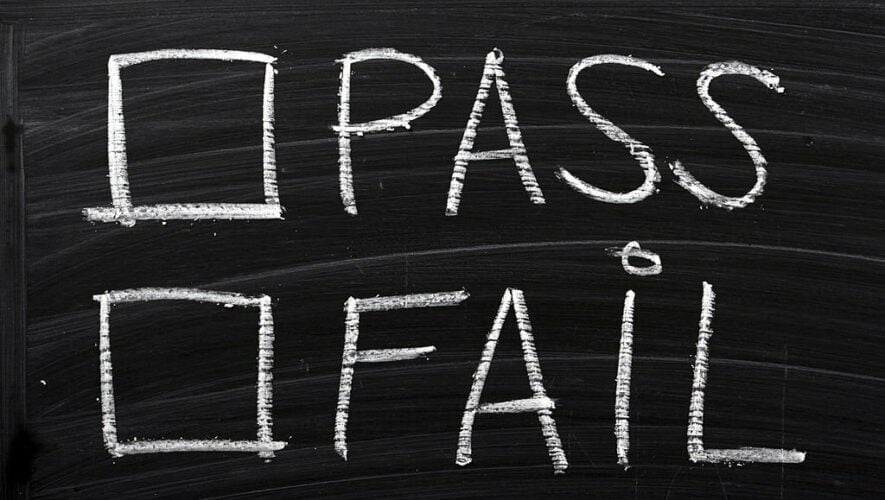If these inspection reports were like tests taken in a classroom, Crowe and Moss Adams would have received passing grades, while Marcum would have failed big time. Let’s take a look:
Crowe
The latest audit inspection results for Crowe show the 11th-ranked public accounting firm by revenue bombed 27% of the audits reviewed in the most recent PCAOB inspection cycle, but the firm was less bad in its 2020 report card than it was in 2019’s.
PCAOB inspectors selected 15 audits to dissect and found problems in just four. That’s better than the results in Crowe’s 2019 inspection report, which revealed Crowe auditors failed half of the 14 audits inspected.

Of the four wayward audits in Crowe’s 2020 inspection report, three had deficiencies in both financial statement audits and the audit of internal control over financial reporting. Of the internal control audit failures, Crowe was dinged the most for not performing sufficient testing of the design and/or operating effectiveness of controls selected for testing. On the financial statement audit side, Crowe got called out for not sufficiently evaluating significant assumptions or data that the issuer used in developing an estimate.
Across the four botched audits, inspectors revealed that only two auditing standards weren’t followed correctly: AS 2501, Auditing Accounting Estimates, and AS 2201, An Audit of Internal Control Over Financial Reporting That Is Integrated with An Audit of Financial Statements.
Moss Adams
After looking at the results of Moss Adams’s last three PCAOB inspection reports, you can conclude that auditors at the 12th-ranked public accounting firm are consistent with how many audits they screw up. In the 12 audits inspected in 2020, 11 in 2019, and 10 in 2018, Moss Adams failed three audits in each of those three years. But as the PCAOB has selected one more audit to inspect in each of those years, Moss Adams’s error rate has gotten better: 30% in 2018, 27% in 2019, and 25% in 2020.

In Moss Adams’s latest report, inspectors found errors with the audit of ICFR in only one of the three botched audits, while all three exhibited problems with the financial statement audit. The most erroneous part of the financial statement audit was auditors not performing sufficient testing related to an account or significant portion of an account or to address an identified risk. Issuer A was the most problematic for Moss Adams auditors as inspectors identified multiple deficiencies in the financial statement and ICFR audits related to revenue, accounts receivable, and inventory. For example, mistakes made under inventory included:
The issuer performed cycle counts of inventory held at certain locations. The following deficiencies were identified:
- The firm did not identify and test any controls over the issuer’s monitoring of its cycle-count program. (AS 2201.39)
- The firm selected for testing certain cycle-count controls that it assessed as having a higher risk of failure. To test the design and operating effectiveness of these controls, the firm selected a sample of cycle counts. The firm observed a small number of these counts and, for certain of the remaining counts, inquired of the issuer’s personnel and inspected cycle-count documentation. The firm’s procedures for the unobserved counts did not provide sufficient appropriate audit evidence given the assessed higher risk associated with these controls. (AS 2201.46)
- The firm did not perform any substantive procedures to test the existence of inventory held at certain of these locations. (AS 2301.08)
The firm selected for testing a control that consisted of the issuer’s review and approval of the reserve for excess and obsolete inventory. The firm did not identify and test any controls over the accuracy and completeness of the reports that the issuer used in the operation of this control. (AS 2201.39)
The PCAOB notes that of the three deficient audits, one was for an issuer in the energy sector, one was in the financials sector, and one was for an issuer in the IT sector.
Marcum
Of the three firms highlighted in this post, Marcum’s 2020 inspection report was by far the worst—like BDO USA-level bad. And Marcum’s audit quality has gotten worse over the last three years. The 15th-ranked public accounting firm’s deficiency rate has deteriorated from 30% in 2018 to 50% in 2019 to a horrendous 64% in 2020.

Marcum auditors didn’t do too badly on audits of ICFR. It was financial statement audits that were a nightmare, as the firm blew nearly every one of them. Eight of the nine failed audits contained problems in the audit of financial statements. The litany of errors included:

Issuer A looked like it was a fun client—fun for us as observers but not so much for Marcum auditors:
Type of audit and related areas affected
In our review, we identified deficiencies in the financial statement and ICFR audits related to Revenue and Inventory.
Description of the deficiencies identified
With respect to Revenue at one of the issuer’s business units:
The firm did not identify and test any controls over the accuracy and completeness of the shipment information from the system that the issuer used to record revenue. (AS 2201.39)
The firm selected for testing controls that consisted of the issuer’s review of sales orders. The firm used the results of its substantive testing of this revenue as evidence that these controls were operating effectively. The firm’s procedures did not provide sufficient appropriate audit evidence because the firm did not directly test the review procedures that the control owners performed. (AS 2201.42, .44, and .B9)
The firm selected for testing a control that consisted of the issuer’s review of the calculation of the rebate accrual. The firm did not identify and test any controls over the accuracy and completeness of the system-generated reports used in the operation of this control. (AS 2201.39)
With respect to Inventory at one of the issuer’s business units:
The firm did not identify and test any controls that addressed the issuer’s determination of the cost of its inventory and whether the amounts relieved from inventory and recorded to cost of goods sold were accurate. (AS 2201.39)
The firm selected for testing the issuer’s daily cycle-count control over the existence of this inventory. The small number of cycle-counts that the firm selected for testing did not provide sufficient appropriate audit evidence in light of the frequency of the operation of the control. (AS 2201.46)
The firm selected for testing a control that consisted of the issuer’s review of the reserve for excess and obsolete inventory. The firm did not identify and test any controls over the accuracy and completeness of the system-generated report used in the operation of this control. (AS 2201.39)
Due to the deficiency related to the cycle-count control discussed above, the firm did not obtain sufficient appropriate audit evidence that the cycle-count procedures the issuer used for this inventory were sufficiently reliable to produce results substantially the same as those that would have been obtained by a count of all items each year. (AS 2510.11)
The PCAOB called out the most failures in the following five auditing standards: AS 1105, Audit Evidence; AS 2201, An Audit of Internal Control Over Financial Reporting That Is Integrated with An Audit of Financial Statements; AS 2502, Auditing Fair Value Measurements and Disclosures; AS 2510, Auditing Inventories; and AS 2810, Evaluating Audit Results.
Better luck next time, Marcum.



